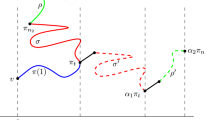Abstract
Let X = (VX, EX) be an infinite, locally finite, connected graph without loops or multiple edges. We consider the edges to be oriented, and EX is equipped with an involution which inverts the orientation. Each oriented edge is labelled by an element of a finite alphabet Σ. The labelling is assumed to be deterministic: edges with the same initial (resp. terminal) vertex have distinct labels. Furthermore, it is assumed that the group of label-preserving automorphisms of X acts quasi-transitively. For any vertex o of X, consider the language of all words over Σ which can be read along self-avoiding walks starting at o. We characterize under which conditions on the graph structure this language is regular or context-free. This is the case if and only if the graph has more than one end, and the size of all ends is 1, or at most 2, respectively.
Similar content being viewed by others
References
S. E. Alm and S. Janson: Random self-avoiding walks on one-dimensional lattices, Comm. Statist. Stochastic Models6 (1990), 169–212.
A. V. Anisimov: Group languages, Kibernetika4 (1971), 18–24.
R. Bauerschmidt, H. Duminil-Copin, J. Goodman and G. Slade: Lectures on self-avoiding walks, in: Probability and Statistical Physics in Two and more Dimensions, 395–467, Clay Math. Proc. 15, Amer. Math. Soc., Providence, RI, 2012.
T. Ceccherini-Silberstein, M. Coornaert, F. Fiorenzi, P. E. Schupp and N. W. M. Touikan: Multipass automata and group word problems, Theoret. Comput. Sci.600 (2015), 19–33.
T. Ceccherini-Silberstein and W. Woess: Growth and ergodicity of context-free languages, Trans. Amer. Math. Soc.354 (2002), 4597–4625.
T. Ceccherini-Silberstein and W. Woess: Context-free pairs of groups I: Context-free pairs and graphs, European J. Combin.33 (2012), 1449–1466.
N. Chomsky and M.-P. Schützenberger: The algebraic theory of context-free languages, in: Computer Programming and Formal Systems26 (P. Braffort abd D. Hirschberg, eds.), North-Holland, Amsterdam, 1963, 118–161.
W. Dicks and M. J. Dunwoody: Groups acting on graphs, Cambridge Studies in Advanced Mathematics17, Cambridge Univ. Press, Cambridge, 1989.
V. Diekert and A. Weiss: Context-free groups and their structure trees, Internat. J. Algebra Comput.23 (2013), 611–642.
C. Droms, B. Servatius and H. Servatius: The structure of locally finite two-connected graphs, Electron. J. Combin. 2 (1995), Research Paper 17.
H. Duminil-Copin and St. Smirnov: The connective constant of the honeycomb lattice equals \(\sqrt {2 + \sqrt 2} \), Ann. of Math.175 (2012), 1653–1665.
M. J. Dunwoody and B. Krön: Vertex cuts, J. Graph Theory80 (2015), 136–171.
P. J. Flory: The configuration of a real polymer chain, J. Chem. Phys.17 (1949), 303–310.
H. Freudenthal: Über die Enden diskreter Räume und Gruppen, Comment. Math. Helv.17 (1945), 1–38.
L. A. Gilch and S. Müller: Counting self-avoiding walks on free products of graphs, Discrete Math.340 (2017), 325–332.
R. Halin: über unendliche Wege in Graphen, Math. Ann.157 (1964), 125–137.
R. Halin: Automorphisms and endomorphisms of infinite locally finite graphs, Abh. Math. Sem. Univ. Hamburg39 (1973), 251–283.
J. M. Hammersley: Percolation processes. II. The connective constant, Proc. Cambridge Philos. Soc.53 (1957), 642–645.
M. A. Harrison: Introduction to Formal Language Theory, Addison-Wesley, Reading, MA, 1978.
W. Imrich and N. Seifter: A note on the growth of transitive graphs, Discrete Math.73 (1989), 111–117.
W. Imrich and N. Seifter: A survey on graphs with polynomial growth, Discrete Math.95 (1991), 101–117.
H. A. Jung and M. E. Watkins: Fragments and automorphisms of infinite graphs, European J. Combin.5 (1984), 149–162.
C. Lindorfer: The Language of Self-Avoiding Walks, Springer Spektrum, BestMasters series, 2018.
N. Madras and G. Slade: The Self-avoiding Walk, Probability and its Applications, Birkhäuser, Boston, MA, 1993.
D. E. Muller and P. E. Schupp: Groups, the theory of ends and context-free languages, J. Comput. System Sc.26 (1983), 295–310.
D. E. Muller and P. E. Schupp: The theory of ends, pushdown automata, and second-order logic, Theoretical Computer Science37 (1985), 51–75.
L. Pélecq: Automorphism groups of context-free graphs, Theoret. Comput. Sci.165 (1996), 275–293.
G. Sabidussi: On a class of fixed-point-free graphs, Proc. Amer. Math. Soc.9 (1958), 800–804.
J.-P. Serre: Trees, Translated from the French by J. Stillwell. Springer-Verlag, Berlin-New York, 1980.
C. Thomassen and W. Woess: Vertex-transitive graphs and accessibility, J. Combin. Theory Ser. B58 (1993), 248–268.
V. I. Trofimov: Groups of automorphisms of graphs as topological groups, Mat. Zametki38 (1985), 378–385.
W. T. Tutte: Graph Theory, with a foreword by C. St. J. A. Nash-Williams, Encyclopedia of Mathematics and its Applications 21, Addison-Wesley, Reading, MA, 1984.
W. Woess: Context-free pairs of groups. II - cuts, tree sets, and random walks, Discrete Math.312 (2012), 157–173.
W. Woess: Random Walks on Infinite Graphs and Groups, Cambridge Tracts in Mathematics 138, Cambridge University Press, Cambridge, 2000.
D. Zeilberger: Self-avoiding walks, the language of science, and Fibonacci numbers, J. Statist. Plann. Inference54 (1996), 135–138.
Author information
Authors and Affiliations
Corresponding author
Additional information
This work is partially supported by Austrian Science Fund FWF P31237 and DK W1230.




